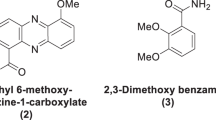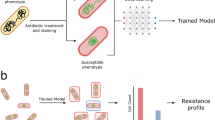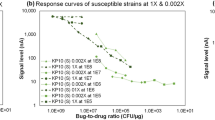Abstract
Prosthetic joint infections (PJI) are severe complications in Orthopedics, with Staphylococcus aureus and Staphylococcus epidermidis being the most commonly isolated pathogens. The variable antimicrobial susceptibility found in these microorganisms, along with the increasing number of methicillin-resistant strains, increases the difficulty of antibiotic selection and makes it necessary to perform individual susceptibility studies to select the optimal antibiotic treatment. The aim of this study was to evaluate the in vitro susceptibility pattern of 35 clinical strains isolated from PJI (17 S. aureus and 18 S. epidermidis) against rifampin, vancomycin, tygecicline, clindamycin, cotrimoxazole, cloxacillin, ciprofloxacin, daptomycin and fosfomycin. In vitro susceptibility assays were performed using the broth microdilution method and agar dilution for fosfomycin. MBC was also determined. Tygecicline and daptomycin showed the highest antimicrobial activity with low MIC90 values, and no resistant strains were detected. On the other hand, ciprofloxacin and cloxacillin exhibited a poor antimicrobial effect with a high percentage of nonsusceptible strains in both species. Bactericidal activity rates revealed the bacteriostatic behavior of rifampin, tygecicline, cotrimoxazole, fosfomycin and clindamycin, whereas vancomycin and cloxacillin showed species- and strain-dependent behavior. Daptomycin and ciprofloxacin were observed to be efficient bactericidal agents against the tested strains. According to our data, rifampin, tigecycline, daptomycin and fosfomycin showed high in vitro activity against most staphylococcal strains isolated from the PJIs tested, although daptomycin seems to be the best alternative to vancomycin therapy.
Similar content being viewed by others
Log in or create a free account to read this content
Gain free access to this article, as well as selected content from this journal and more on nature.com
or
References
Lentino, J. R. Prosthetic joint infections: bane of orthopedists, challenge for infectious disease specialists. Clin. Infect. Dis. 36, 1157–1161 (2003).
Anagnostakos, K., Schmid, N. V., Kelm, J., Grun, U. & Jung, J. Classification of hip joint infections. Int. J. Med. Sci. 6, 227–233 (2009).
Trampuz, A. & Zimmerli, W. Prosthetic joint infections: update in diagnosis and treatment. Swiss Med. Wkly. 135, 243–251 (2005).
Bernard, L. et al. Trends in the treatment of orthopaedic prosthetic infections. J. Antimicrob. Chemother. 53, 127–129 (2004).
Geipel, U. Pathogenic organisms in hip joint infections. Int. J. Med. Sci. 6, 234–240 (2009).
Del Pozo, J. L. & Patel, R. Clinical practice. Infection associated with prosthetic joints. N. Engl. J. Med. 361, 787–794 (2009).
Parvizi, J., Azzam, K., Ghanem, E., Austin, M. S. & Rothman, R. H. Periprosthetic infection due to resistant staphylococci: serious problems on the horizon. Clin. Orthop. Relat. Res. 467, 1732–1739 (2009).
Cremniter, J. et al. Decreased susceptibility to teicoplanin and vancomycin in coagulase-negative Staphylococci isolated from orthopedic-device-associated infections. J. Clin. Microbiol. 48, 1428–1431 (2010).
Hawser, S. P., Bouchillon, S. K., Hoban, D. J., Dowzicky, M. & Babinchak, T. Rising incidence of Staphylococcus aureus with reduced susceptibility to vancomycin and susceptibility to antibiotics: a global analysis 2004-2009. Int. J. Antimicrob. Agents 37, 219–224 (2011).
Rice, D. A. & Mendez-Vigo, L. Daptomycin in bone and joint infections: a review of the literature. Arch. Orthop. Trauma Surg. 129, 1495–1504 (2009).
Drancourt, M. et al. Oral rifampin plus ofloxacin for treatment of Staphylococcus-infected orthopedic implants. Antimicrob. Agents Chemother. 37, 1214–1218 (1993).
Stein, A. et al. Ambulatory treatment of multidrug-resistant Staphylococcus-infected orthopedic implants with high-dose oral co-trimoxazole (trimethoprim-sulfamethoxazole). Antimicrob. Agents Chemother. 42, 3086–3091 (1998).
Saginur, R. et al. Multiple combination bactericidal testing of staphylococcal biofilms from implant-associated infections. Antimicrob. Agents Chemother. 50, 55–61 (2006).
Gallo, J. et al. In vitro testing of gentamicin-vancomycin loaded bone cement to prevent prosthetic joint infection. Biomed. Pap. Med. Fac. Univ. Palacky Olomouc. Czech Repub 149, 153–158 (2005).
Bassetti, M. et al. Linezolid in the treatment of Gram-positive prosthetic joint infections. J. Antimicrob. Chemother. 55, 387–390 (2005).
Esteban, J. & Cordero-Ampuero, J. Treatment of prosthetic osteoarticular infections. Expert Opin. Pharmacother. 12, 899–912 (2011).
Valle, J. et al. SarA and not sigmaB is essential for biofilm development by Staphylococcus aureus. Mol. Microbiol. 48, 1075–1087 (2003).
Esteban, J. et al. Evaluation of quantitative analysis of cultures from sonicated retrieved orthopedic implants in diagnosis of orthopedic infection. J. Clin Microbiol. 46, 488–492 (2008).
CLSI Performance Standards for Antimicrobial Susceptibility Testing. Twenty-first informational supplement In M100-S21 Vol 31 No 1 (2012).
EUCAST Breakpoint tables for interpretation of MICs and zone diameters In Version 2.0 (2012).
Amsterdam, D. Susceptibility testing of antimicrobials in liquid media In Antibiotics in Laboratory Medicine (Ed., V.L.) 102–103 Williams & Wilkins: Philadelphia, (1996).
Schito, G. C. The importance of the development of antibiotic resistance in Staphylococcus aureus. Clin. Microbiol. Infect. 12 (Suppl 1) 3–8 (2006).
Deurenberg, R. H. et al. The molecular evolution of methicillin-resistant Staphylococcus aureus. Clin. Microbiol. Infect. 13, 222–235 (2007).
von Eiff, C. Staphylococcus aureus small colony variants: a challenge to microbiologists and clinicians. Int. J. Antimicrob. Agents 31, 507–510 (2008).
Schafer, P. et al. Prolonged bacterial culture to identify late periprosthetic joint infection: a promising strategy. Clin. Infect. Dis. 47, 1403–1409 (2008).
Vaudaux, P., Kelley, W. L. & Lew, D. P. Staphylococcus aureus small colony variants: difficult to diagnose and difficult to treat. Clin. Infect. Dis. 43, 968–970 (2006).
Sendi, P. et al. Staphylococcus aureus small colony variants in prosthetic joint infection. Clin. Infect. Dis. 43, 961–967 (2006).
Kourbatova, E. V. et al. Emergence of community-associated methicillin-resistant Staphylococcus aureus USA 300 clone as a cause of health care-associated infections among patients with prosthetic joint infections. Am. J. Infect. Control\ 33, 385–391 (2005).
Vindel, A. et al. Methicillin-resistant Staphylococcus aureus in Spain: molecular epidemiology and utility of different typing methods. J. Clin. Microbiol. 47, 1620–1627 (2009).
Srinivasan, A., Dick, J. D. & Perl, T. M. Vancomycin resistance in staphylococci. Clin. Microbiol. Rev. 15, 430–438 (2002).
Zimmerli, W., Widmer, A. F., Blatter, M., Frei, R. & Ochsner, P. E. Role of rifampin for treatment of orthopedic implant-related staphylococcal infections: a randomized controlled trial. Foreign-Body Infection (FBI) Study Group. JAMA 279, 1537–1541 (1998).
Picazo, J. J. et al. Comparative activities of daptomycin and several agents against staphylococcal blood isolates. Glycopeptide tolerance. Diagn. Microbiol. Infect. Dis. 70, 373–379 (2011).
Sader, H. S., Fritsche, T. R. & Jones, R. N. Daptomycin bactericidal activity and correlation between disk and broth microdilution method results in testing of Staphylococcus aureus strains with decreased susceptibility to vancomycin. Antimicrob. Agents Chemother. 50, 2330–2336 (2006).
Acknowledgements
This work was supported by Comunidad de Madrid (BITI-CAM project S2009/MAT-1472) and Ministerio de Educación y Ciencia (project CONSOLIDER FUNCOAT CSD2008-00023). DMM was funded by the Fundación Conchita Rábago de Jiménez Díaz. AOP and GDP were funded by the Comunidad de Madrid. We acknowledge Mr Oliver Shaw for his help with English language.
Author information
Authors and Affiliations
Corresponding author
Rights and permissions
About this article
Cite this article
Molina-Manso, D., del Prado, G., Ortiz-Pérez, A. et al. In vitro susceptibility of Staphylococcus aureus and Staphylococcus epidermidis isolated from prosthetic joint infections. J Antibiot 65, 505–508 (2012). https://doi.org/10.1038/ja.2012.62
Received:
Revised:
Accepted:
Published:
Issue date:
DOI: https://doi.org/10.1038/ja.2012.62
Keywords
This article is cited by
-
Antimicrobial treatment of patients with a periprosthetic joint infection: basic principles
Arthroplasty (2023)
-
Antibacterial effect of antibiotic-loaded SBA-15 on biofilm formation by Staphylococcus aureus and Staphylococcus epidermidis
The Journal of Antibiotics (2017)
-
Effect of different agents with potential antibiofilm activity on antimicrobial susceptibility of biofilms formed by Staphylococcus spp. isolated from implant-related infections
The Journal of Antibiotics (2016)



